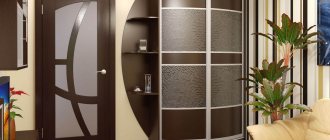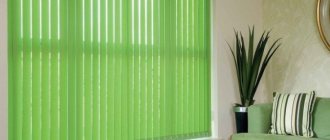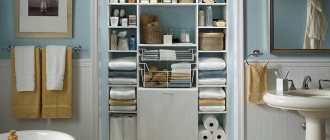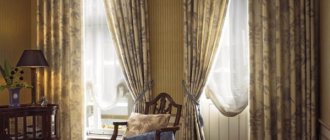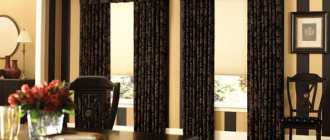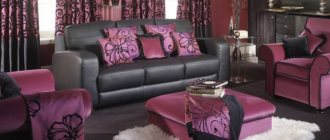The hall is a place that is constantly under close attention, because it is where the whole family gathers in the evenings and guests on holidays, so the design of the living room needs to be thought through very carefully. It is necessary to take into account all the nuances - color combinations, layout and decor. The final and important stage is the design of window openings. With the help of tulle you can completely change the image of a room, making it light and airy. It seems that all the possibilities of tulle are already known, but every year designers create new interesting options for using this material as decoration.
Tips for choosing
Tulle is used to decorate windows in different stylistic directions - classic, minimalism, country, this material is in harmony with any room design. Window drapery and color choice directly depend on the size of the room, lighting and style of the living room.
If the windows face south or east, then during the day the room is sufficiently lit, so the fabric must be chosen either thick or dark. This will dim the too bright sunlight. But you need to remember that such a technique will be advantageous in a large room, but will visually reduce a small one.
To visually expand a small room, it is better to use light, transparent tulle. If the window is small, then you can hang a cornice that is longer than its width, this will make the room more spacious and the opening larger. Designers often use a technique that visually enlarges a room - they choose tulle with vertical stripes for windows.
It is sold ready-made or in rolls. When choosing a finished product, you need to take into account the height of the ceiling, the width of the windows and cornice. If you sew to order, you first need to choose a fabric and agree on a design that suits the stylistic direction of the living room. It is necessary to discuss all the nuances with the seamstress in advance - what kind of fastening will be used, decorative elements, tiebacks.
Each room has its own curtain
When creating a window design with tulle curtains, you should remember that fashion does not deny practicality and functionality. In the living room, curtains draped with a sheer curtain look fashionable. In the kitchen this option looks ridiculous.
Living room
A festive but unobtrusive atmosphere is created here. Tulle in a modern hall can play two roles: accent and background. Both contrasting combinations and monochrome ones with a difference of several tones are relevant. In this case, there is no need to hang blue curtains with red tulle. Dark green drapes combined with a white curtain are an example of contrast. The same curtains with a soft green curtain create a monochrome interior.
You can make your living room fashionable using different methods:
- Hang tulle with a floral pattern, guipure inserts, lace or just a bright fabric that matches the style of the room;
- Decorate the window with lush drapery, install a beautiful lambrequin on the tulle, effectively pin or pick up the fabric;
- Experiment with modern materials - chameleon or rainbow organza, metallic fabrics;
- Pay attention to fashionable colors - wine, river water, black and white.
Bedroom
For the bedroom, you need to choose tulle for the windows so that the atmosphere in the room is relaxing and soothing. Bright colors will not be the best solution. It is advisable to use pastel shades. The light transmission of curtains depends not on color, but on the density of the material. The soft folds formed by the veil, combined with its ability to diffuse light, look great in any bedroom.
A curtain made of lace, with a pattern or guipure inserts will help make the room elegant. The floor length will emphasize the romance of the bedroom.
Children's
A transparent curtain in a nursery participates in creating a thematic composition or easily fits into the style of the room, fulfilling its functions. The choice of tulle is based on the environmental friendliness of the material and the safety of the child. Since curtains occupy a large area, special attention is paid to the choice of color. Designers recommend using subdued tones. Fabric with a children's pattern is suitable. Bright curtains cause emotional fatigue.
What types of tulle are there for the hall:
Tulle production is on a large scale, so choosing the right option is easy. The following fabrics are most often used for sewing:
- silk;
- organza;
- muslin;
- veil;
- cotton;
- linen;
- nylon;
- tulle;
- viscose.
Silk, linen and cotton fabric are natural materials. Tulle made from these fabrics will look beautiful and rich. They are environmentally friendly, but unlike synthetics, they are not durable. To prevent it from losing its aesthetic appearance, it needs to be carefully and regularly looked after.
Although synthetic is not a natural material, its main advantage is that it does not require special care and at the same time lasts a long time. Another advantage of synthetics is that they are cheaper than natural fabrics, and the choice allows you to choose the right option for any style.
The appearance of tulle can be different - smooth, with patterns or decorative elements. Smooth tulle is made from organza, cotton or silk. It is light and transparent, creating a feeling of airiness and light.
Patterned tulle can be with a pattern, lace, it can be crinkled or in the form of a mesh. The pattern is applied to the surface of the material or a pattern is created by interweaving fibers. A printed pattern is a great option for a bright living room.
A printed pattern is an excellent option for a bright living room; applying a 3D pattern to tulle would also be an interesting option.
Tulle with lace is made on special machines from expensive material, so it is not a cheap pleasure. It can be completely lace or partially, performing only a decorative role.
Textured tulle is made by weaving threads of different thicknesses. Due to this, heterogeneous nodules and tracks with different patterns are obtained on the surface. It will be interesting to look at muslin - a light thread tulle that lets in a lot of sunlight.
Materials for making tulle
When choosing a material, you should take into account the seasonality of its use. An important criterion for choosing tulle for a room without curtains is the completeness of the appearance of the entire structure. The material can be combined from dense and transparent fabric, which is plain or decorated. Grommet curtains are a common option for this design.
You may also be interested in: Choosing a curtain design for the hall
If you choose curtains made of fabric with a complex texture, they can be successfully combined with tulle curtains. Making a product yourself is quite difficult, since the type of fabric is always taken into account during the cutting and sewing process. Improper sewing will lead to the material being overstretched, wrinkles forming on it, as well as a number of unaesthetic waves.
If you combine synthetic tulle material with artificial curtains, then these 2 interior elements may not look the way the owner of the room would like. Artificial and natural light will distort the shades of the curtains. This factor is important to consider when choosing material for them.
The use of complex decorative elements in the interior requires a choice. These models can consist of several layers, including additional elements. Tulle looks beautiful with a lambrequin and artificial inserts. It emphasizes the originality of the luxurious room, where elegant pieces of furniture are located.
The opening should be decorated very responsibly, since it represents the basis of the interior. A wide variety of fasteners, materials, and accessories allows you to create even quite complex images. If you don’t want to show your creative imagination, then it’s enough to opt for a suitable ready-made kit.
Tulle with lambrequin
Lambrequin is a decorative textile drapery that is placed horizontally, at the top of the window, across the entire width of the cornice. Recently, it has become fashionable to complement tulle with a lambrequin without using curtains. This will be especially convenient in the living room, where a lot of daylight is required.
When sewing a rigid lambrequin, dense fabrics are used, which are treated with interlining or dublerin to maintain density. In addition, such a lambrequin is stretched over a wooden or plastic frame. It goes well with tulle and is in harmony with the rest of the interior elements. The lambrequin can be of any shape - arch, rectangle, etc.
A soft lambrequin is used in the living room to create a formal atmosphere. The simplest option is a strip of fabric gathered with braid. It creates a harmonious ensemble with tulle and other decorative elements.
The combined lambrequin has a complex design and is divided into several varieties:
- The same frill - lambrequin is located along the edges, has an oblique cut in order to form folds.
- Tie – hangs in the middle, has a triangle shape and soft smooth folds.
- A bouffant lambrequin resembles wicker and is most often made from bright, rich fabrics.
- Bell - conical folds, horizontal in shape.
- The mold is double folds that overlap each other.
- Svagi is a lambrequin in the shape of a semicircle, complemented by fringe or tassels.
A combined lambrequin will create an original design in the living room and complement the classic style.
New for 2020
This year, a lambrequin with tulle without unnecessary decorative elements, a laconic and straight cut will be relevant. The color should be monochromatic, without complex geometric patterns. You can use a thin horizontal or vertical strip. This option is suitable for classic style and minimalism.
Also in fashion are bright, rich colors that warm you up in winter, give you a good mood, give you energy and positivity. Blue, emerald or green will look harmonious in the living room.
Everything natural is trending - environmentally friendly fabric and natural color. The design with leaves and flowers has remained popular for many years.
Another interesting option for decorating the hall is a lambrequin and chameleon-colored tulle. It will shimmer in the light and create a romantic atmosphere. Combining matte and satin fabrics with each other remains in fashion; they can be adapted to any living room interior.
A lambrequin with fringe, beads, and rhinestones will look interesting in an oriental style room. In a classic style, rhinestones will be inappropriate. When choosing, you need to take into account all the nuances - the area of the room, the overall interior, the color of the wall furniture. So, for a large living room, abundant decoration of window openings is suitable, but it is better not to overload a small one with unnecessary elements.
It is necessary to carefully consider the design of the tulle so that it fulfills not only a functional role, but also pleases the eye with its aesthetic appearance and gives a good mood.
How to choose tulle for the hall
allow you to visually increase the height of the ceiling and give harmony to the interior. If they are chosen correctly, the atmosphere of the room becomes more comfortable. The practicality of tulle is to protect the room from sunlight and from the gaze of passers-by.
The correct choice of curtains provides not only an aesthetic, but also a practical purpose for decorating a room. It consists in protecting it from the sun or visually expanding the space. Ready-made curtains for the hall have their own advantages. When tailoring individually, you can choose tulle of different colors, styles and sizes.
To choose the right tulle, you will need to decide in advance where the curtains will be located. Since curtains play different roles in the interior, they can represent an interesting accent or background for exclusive items in the room.
You can choose suitable tulle based on the following rules:
- classic style involves choosing curtains made in soothing colors;
- you can combine contrasting colors depending on the size of the room;
- saturated shades are not suitable for small spaces.
The selected tulle color should be psychologically favorable. For example, black color can have a suppressive effect on the human nervous system. This color should not be allowed to overshadow the others, so it is best to use it only for contrast. If you focus your attention on bright orange curtains, they will irritate even choleric people.
The selected tulle can be hung on curtains with eyelets, which have a number of advantages:
- reliable fastening of curtains to the cornice;
- a spectacular view due to the beautiful waves with which the tulle falls;
- ease of use, as they are easily pulled.
You may also be interested in: Color combination in the interior
When choosing, you should choose the most suitable option that will complete the interior, since tulle can transform a room.
Tulle without curtains in the living room interior:
Next you will see various options for how you can organize tulle in a room without curtains. Spacious, open living rooms that saturate the area with light and air. Minimalism style, bed colors + a small accent will make your room sophisticated in 2020.
